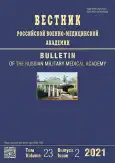Norm and human health
- Authors: Malov Y.S.1, Borisov I.M.1
-
Affiliations:
- Military Medical Academy named after S.M. Kirov of the Ministry of Defense of the Russian Federation
- Issue: Vol 23, No 2 (2021)
- Pages: 229-236
- Section: Reviews
- URL: https://journals.rcsi.science/1682-7392/article/view/70958
- DOI: https://doi.org/10.17816/brmma70958
- ID: 70958
Cite item
Abstract
The concept of «norms» is common to biology and medicine. It represents the essence of any phenomenon. In medicine, human health is expressed through the category of norm. The basis of the construction of the norm (normology) should be based on the principle of correspondence of morphofunctional properties of the organism to the environment, and not their nature. And then indicators that reflect the stability of a living non-equilibrium system or the state of an adapted organism will characterize (normal) human health. The norm is always stable, otherwise it will not be the norm. The science of human health developed through analysis — the decomposition of a complex whole into simple parts. In this case, the object disappeared as a whole, as a system with all its inherent features. The norm was derived from the fitness, balance of the body with the environment. Recently, it has become possible to consider a person as a system that is determined by the relationship of the whole and its parts (the golden ratio). In biology, the golden ratio manifests itself in many ways, from the structure of polypeptides to the human body. The study of a living organism as a system allowed us to establish the harmonic essence of its structure. The idea of the harmony of the world of systems is connected with the relations of "opposites" within the object. The "golden opposites" of healthy people are a kind of norm reference. What brings "opposites" to unity is harmony. Harmony is closely related to the golden ratio. Golden harmony is the basis of human health. Mathematical expression of harmony, symmetry — a method of assessing (norm) human health. Deviations from the "golden" relations can be used in medicine as indicators (criteria) for the diagnosis of pathological disorders.
Keywords
Full Text
##article.viewOnOriginalSite##About the authors
Yuri S. Malov
Military Medical Academy named after S.M. Kirov of the Ministry of Defense of the Russian Federation
Email: malov36@yandex.ru
doctor of medical sciences, professor
Russian Federation, Saint-PetersburgIgor M. Borisov
Military Medical Academy named after S.M. Kirov of the Ministry of Defense of the Russian Federation
Author for correspondence.
Email: Askbo@mail.ru
candidate of medical sciences
Russian Federation, Saint-PetersburgReferences
- Dolinin VA, Petlenko VP, Popov LS. Dialektika i logika klinicheskogo michlenija. Leningrad; 1982. (In Russ.).
- Korolkov AA, Petlenko VP. Philosofskie problemi teorii normi v biologii I medicine. Moscow: Medicina; 1977. (In Russ.).
- Vernadskii VI. Nauchnaja misl kak planetarnoe javlenie. Moscow: Nauka; 1991. (In Russ.).
- Oparin AI. Vozniknovenie i nachalnoe razvitie zisni. Moscow: Medicina; 1966. (In Russ.).
- Tejar de Charden P. Phenomen cheloveka. Moscow: Nauka; 1987. (In Russ.).
- Cvetkov VD. Serdce, zolotaja garmonija i optimalnost. Pushino; 2014. (In Russ.).
- Schmalgauzen II. Organizm, kak celoe v individualnom i istoricheskom razvitii. Moscow: Nauka; 1980. (In Russ.).
- Baevskii RM. Health problems and norms physiologist’s point of view. Clinical Medicine. 2000;4:59–64. (In Russ.).
- Brehman II. Valeologija — nauka o zdorove. Moscow: Phizkultura i sport; 1987. (In Russ.).
- Vorobev EI. Zdorovie I okruxauchaja sreda. Vestnik Akademii meditsinskikh nauk SSSR. 1985;5:84–87. (In Russ.).
- Malov YS. Biologicheskie osnovi zdorovija i boleznei cheloveka. St. Petersburg; 2007. (In Russ.).
- Dilman VM. Chetiri modeli medicini: monografija. Leningrad: Medicina; 1980. (In Russ.).
- Subbota AG. «Zolotoe sechenie» (Sectio aurea) v medicine. St. Petersburg: Stroipechat; 1996. (In Russ.).
- Engelgard VA. Poznanie javlenii zizni: monografija. Moscow: Nauka; 1984. (In Russ.).
- Cvetkov VD. Zolotaja garmonija i optimalnost. Pushino; 2008. (In Russ.).
- Soroko EM. Zolotoe sechenie, processi samoorganizacii i evolucii sistem. Moscow: Konkniga; 2009. (In Russ.).
- Cvetkov VD. Zolotoe sechenie i simmetrija. Moscow: Nauka; 1999. (In Russ.).
- Vasutinskii NA. Zolotaja proporcia. St. Petersburg: Dila; 2006. (In Russ.).
- Gurevich EV, Shkarin VV. Zolotoe sechenie v medicine. Mistika ili universalni kriterii. Medicum. 2002;9:116–121. (In Russ.).
- Simonjan КS. Peritonit. Moscow: Medicina; 1971. (In Russ.).
- Urmancev YA. Simmetrija prirodi i priroda simmetrii. Moscow: Konkniga; 2006. (In Russ.).
- Malov YS. Chronicheskaja serdechnaja nedostatochost (patogenez, klinika, diagnostika, lechenie. St. Petersburg: SpecLit; 2014. (In Russ.).
- Malov YS, Kulikov AN. Symmetry approach to research of heart and its pathology. Vestnik Rossiiskoi voenno-medicinskoi academii. 2014;2(46):51–57. (In Russ.).
- Malov YS, Kuchmin AN, Borisov IM, Malova AM. Golden symmetry — an indicator of the norm and pathology of the human heart. Vestnik Rossiiskoi voenno-medicinskoi academii. 2020;2(70): 189–194. (In Russ.).
Supplementary files








